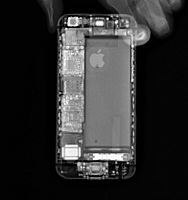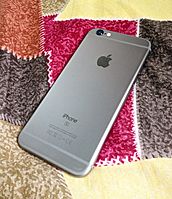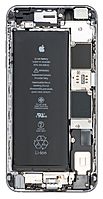IPhone 6s facts for kids
 |
|

iPhone 6s in Rose Gold
|
|
| Brand | Apple Inc. |
|---|---|
| Manufacturer | Foxconn (on contract) |
| Slogan | "The only thing that’s changed is everything." "One powerful phone" |
| Generation | 9th |
| Model | 6s: A1633 (North America) A1688 (International) A1700 (China) 6s Plus: A1634 (North America) A1687 (International) A1699 (China) |
| Compatible networks | GSM, CDMA, 3G, EVDO, HSPA+, LTE/4G, LTE Advanced/4G+ |
| First released | September 25, 2015 |
| Availability by country |
September 25, 2015
October 9, 2015
Andorra
Austria Belgium Bosnia and Herzegovina Bulgaria Croatia Czechia Denmark Estonia Finland Greece Greenland Hungary Iceland Ireland Isle of Man Italy Latvia Liechtenstein Lithuania Luxembourg Maldives Mexico Monaco Netherlands Norway Poland Portugal Romania Russia Slovakia Slovenia Spain Sweden Switzerland Taiwan October 10, 2015
October 16, 2015
November 6, 2015
November 13, 2015
March 31, 2017
|
| Discontinued | September 7, 2016 (16 and 64 GB) September 12, 2018 (32 and 128 GB) |
| Units sold | 13 million in launch weekend |
| Model before | iPhone 6 / iPhone 6 Plus |
| Replacement model | iPhone 7 / iPhone 7 Plus |
| Related | iPhone SE (1st generation) |
| Type | 6s: Smartphone 6s Plus: Phablet |
| Form factor | Slate |
| Size | 6s: 138.3 mm (5.44 in) H 67.1 mm (2.64 in) W 7.1 mm (0.28 in) D 6s Plus: 158.2 mm (6.23 in) H 77.9 mm (3.07 in) W 7.3 mm (0.29 in) D |
| Weight | 6s: 143 g (5.0 oz) 6s Plus: 192 g (6.8 oz) |
| Operating system | Original: iOS 9.0 Current: iOS 15.7.7, released June 21, 2023 |
| System on chip | Apple A9 |
| CPU | 1.85 GHz dual-core 64-bit ARMv8-A "Twister" |
| GPU | PowerVR GT7600 (hexa-core) |
| Memory | 2 GB LPDDR4 RAM |
| Storage | 16, 32, 64, or 128 GB TLC NAND connected via NVMe |
| Battery | 6s: 3.82 V 6.55 W·h (1715 mA·h) Li-Po 150 min charge time for an average of 8 h 15 min use 6s Plus: 3.8 V 10.45 W·h (2750 mA·h) Li-Po 165 min charge time for an average of 9 h 11 min use |
| Screen | 6s: 4.7 in (120 mm) Retina HD, LED-backlit IPS LCD, 1334 × 750 pixel resolution (326 ppi) with Dual Ion Exchange strengthened glass and 3D Touch 6s Plus: 5.5 in (140 mm) Retina HD, LED-backlit IPS LCD, 1920 × 1080 pixel resolution (401 ppi), 500 cd/m2 max. brightness (typical), with Dual Ion Exchange strengthened glass and 3D Touch |
| Rear camera | Sony Exmor RS IMX315 12 MP (1.22 μm), true-tone flash, autofocus, IR filter, burst mode, f/2.2 aperture, 4K video recording at 30 fps or 1080p at 30 or 60 fps, slow-motion video (1080p at 120 fps and 720p at 240 fps), timelapse with stabilization, panorama (up to 63 megapixels), face detection, digital image stabilization, optical image stabilization (6s Plus only) |
| Front camera | 5 MP, burst mode, f/2.2 aperture, exposure control, face detection, auto-HDR, 720p HD video recording, Retina flash |
| Sound | Mono speaker, 3.5 mm stereo audio jack |
| Connectivity |
All models:
LTE (Bands 1 to 5, 7, 8, 12, 13, 17 to 20, 25 to 29), TD-LTE (Bands 38 to 41), TD-SCDMA 1900 (F), 2000 (A), UMTS/HSPA+/DC-HSDPA (850, 900, 1700/2100, 1900, 2100 MHz), CDMA EV-DO Rev. A (800, 1700/2100, 1900, 2100 MHz), GSM/EDGE (850, 900, 1800, 1900 MHz), Wi-Fi (802.11 a/b/g/n/ac), Bluetooth 4.2, NFC, GPS, GLONASS, Galileo & QZSS
Models A1633 and A1634:
LTE (Band 30)
|
| Other | FaceTime audio- or video-calling |
| SAR |
6s
Model A1633, A1688, A1691, A1700
Head: 1.14 W/kg Body: 1.14 W/kg 6s Plus
Model A1634, A1687, A1690, A1699
Head: 1.12 W/kg Body: 1.14 W/kg |
| Hearing aid compatibility | M3, T4 |
The iPhone 6s and iPhone 6s Plus are smartphones that were designed, developed, and marketed by Apple Inc. They are the ninth generation of the iPhone. They were announced on September 9, 2015, at the Bill Graham Civic Auditorium in San Francisco by Apple CEO Tim Cook, with pre-orders beginning September 12 and official release on September 25, 2015. The iPhone 6s and 6s Plus were succeeded by the iPhone 7 and iPhone 7 Plus on September 7, 2016 and were discontinued with the announcement of the iPhone XS, iPhone XS Max, and iPhone XR on September 12, 2018.
The iPhone 6s has a similar design to the iPhone 6 but includes updated hardware, including a strengthened 7000 series aluminum alloy chassis and upgraded Apple A9 system-on-chip, a new 12-megapixel rear camera that can record up to 4K video at 30fps (A first in the series), can take dynamic "Live Photos", the first increase in front camera photo resolution since the 2012 iPhone 5, and also features for the first time front facing "Retina Flash" which brightens up the display three times of its highest possible brightness for selfies, 2nd generation Touch ID fingerprint recognition sensor, LTE Advanced support, and "Hey Siri" capabilities without needing to be plugged in. The iPhone 6s also introduces a new hardware feature known as "3D Touch", which enables pressure-sensitive touch inputs. The iPhone 6s and iPhone 6s Plus are also the first smartphones to use the fastest high end flash storage NVM Express (NVMe). The 6s and 6s Plus, alongside the 1st generation SE, are the longest supported iPhones ever released, through seven major versions of iOS from iOS 9 to iOS 15. They do not support iOS 16 due to hardware limitations.
Contents
History
Before the official unveiling, several aspects of the iPhone 6s were rumored, including the base model having 16 gigabytes of storage, the pressure-sensitive display technology known as 3D Touch, and a new rose gold color option.
iPhone 6s and iPhone 6s Plus were officially unveiled on September 9, 2015, during a press event at the Bill Graham Civic Auditorium in San Francisco. Pre-orders began September 12, with the official release on September 25.
On September 7, 2016, Apple announced the iPhone 7 and 7 Plus as respective successors to the iPhone 6s and 6s Plus, although they continued to be sold at a reduced price point as entry-level options in the iPhone lineup.
On March 31, 2017, the iPhone 6s and 6s Plus were released in Indonesia alongside the iPhone 7 and 7 Plus, following Apple's research and development investment in the country.
The iPhone 6s, iPhone 6s Plus, and first-generation iPhone SE were the last iPhone models to feature a standard 3.5 mm stereo headphone jack, and were discontinued on September 12, 2018, with the release of the iPhone XR.
Specifications
Hardware
Design
The iPhone 6s is nearly identical in design to the iPhone 6. In response to the "bendgate" design flaws of the previous model, changes were made to improve the durability of the chassis: the 6s was constructed from a stronger, 7000 series aluminum alloy, "key points" in the rear casing were strengthened and reinforced, and touchscreen integrated circuits were re-located to the display assembly. Alongside the existing gold, silver, and space gray options, a new rose gold color option was also introduced.
| Color | Name | Front | Antenna |
|---|---|---|---|
| Space Gray | Black | Light Grey | |
| Silver | White | ||
| Gold | White | ||
| Rose Gold |
Chipsets
The iPhone 6s is powered by the Apple A9 system-on-chip, which the company stated is up to 70% faster than Apple A8, and has up to 90% better graphics performance. The iPhone 6s has 2 GiB of RAM, twice as much as any previous iPhone, and also supports LTE Advanced. The Touch ID sensor on the 6s was also updated, with the new version having improved fingerprint scanning performance over the previous version.
Batteries
While the capacities of their non-user-replaceable batteries are slightly smaller (1715 mAh and 2750 mAh respectively), Apple rates the iPhone 6s and 6s Plus as having the same average battery life as their respective predecessors (1810 mAh and 2915 mAh). The A9 system-on-chip was dual-sourced from TSMC and Samsung. Although it was speculated that the Samsung version had worse battery performance than the TSMC version, multiple independent tests have shown there is no appreciable difference between the two chips. Although the device was not promoted as such, the iPhone 6s has a degree of water resistance because of a change to its internal design, which places a silicone seal around components of the logic board and an adhesive gasket around the display assembly to prevent them from being shorted by accidental exposure to water.
Displays
Their displays are the same sizes as those of the iPhone 6, coming in 4.7-inch 750p and 5.5-inch 1080p (Plus) sizes. The iPhone 6s features a technology known as 3D Touch; sensors are embedded in the screen's backlight layer that measure the firmness of the user's touch input by the distance between it and the cover glass, allowing the device to distinguish between normal and more forceful presses. 3D Touch is combined with a Taptic Engine vibrator to provide associated haptic feedback. Although similar, this is distinct from the Force Touch technology used on the Apple Watch and the trackpad of the Retina MacBook, as it is more sensitive and can recognize more levels of touch pressure than Force Touch. Due to the hardware needed to implement 3D Touch, the iPhone 6s is heavier than its predecessor.
Cameras
The iPhone 6s and 6s Plus feature a 12-megapixel (4032×3024 pixels) rear-facing camera, an upgrade from the 8-megapixel (3264×2448) unit on previous models, as well as a 5-megapixel front-facing camera, compared to 1.3 megapixels of the iPhone 5, iPhone 5s, iPhone 6, 6 Plus and iPhone SE.
Their rear camera can record 4K video (3840×2160p) for the first time on an iPhone, as well as FullHD (1920×1080p) video at 30, 60 and now 120 frames per second, the latter also for the first time on an iPhone. The camera was well received by many critics of the phone. When the camera takes a 4K video recording, it can use the storage on the phone rapidly. The 16 gigabyte version of the phone was only capable of holding 40 minutes of 4K video (bit rate: 6 MB/s or 48 Mbit/s).
Still photos with 6.5 megapixels (3412×1920) can be captured during video recording.
Storage
The iPhone 6s and 6s Plus were originally offered in models with 16, 64, and 128 GB (14.9, 59.6 or 119.2 GiB) of internal storage. Following the release of iPhone 7 in September 2016, the 16 and 64 GB models were dropped and replaced by a new 32 GB (29.8 GiB) option. Some of this storage space is used by preinstalled software, resulting in usable storage of 11.5, 27.5, 56.5 and 114 GiB. For improved storage performance, iPhone 6s utilizes NVM Express (NVMe), resulting in a maximum average read speed of 1,840 megabytes per second.
Software
The iPhone 6s originally shipped with iOS 9; the operating system leverages the 3D Touch hardware to allow recognition of new gestures and commands, including "peeking" at content with a light touch and "popping" it into view by pressing harder, and accessing context menus with links to commonly used functions within apps with harder presses on home screen icons. The camera app's "Retina Flash" feature allows the display's brightness to be used as a makeshift flash on images taken with the front camera, while "Live Photos" captures a short video alongside each photo taken.
The iPhone 6s, 6s Plus, and first-generation SE support iOS 12, which was first released on September 17, 2018. They also support iOS 13, unveiled on June 3, 2019, and was released to the public on September 19, 2019; as well as iOS 14, unveiled on June 22, 2020, and iOS 15, unveiled on June 7, 2021. These phones support most of the main features of iOS 13, including dark mode. Along with the iPhone SE, the 6s and 6s Plus are the oldest iPhones to support iOS 13, iOS 14 and iOS 15.
On June 6, 2022, after iOS 16 was announced at the WWDC 2022, it was revealed that the iPhone 6s and 6s Plus along with the first-generation iPhone SE, iPhone 7, and iPhone 7 Plus will not be compatible with this new version of the operating system.
Hardware issues
Unexpected battery shutdowns
In November 2016, Apple announced that a "very small number" of iPhone 6s devices manufactured between September and October 2015 have faulty batteries that unexpectedly shut down. While Apple noted that the battery problems were "not a safety issue", it announced a battery replacement program for affected devices. Customers with affected devices, which span "a limited serial number range", were able to check their device's serial number on Apple's website, and, if affected, receive a battery replacement free of charge at Apple Stores or authorized Apple Service Providers.
In December 2016, Apple revealed new details about the issue, stating that the affected devices contained a "battery component that was exposed to controlled ambient air longer than it should have been before being assembled into battery packs".
See also
 In Spanish: IPhone 6s para niños
In Spanish: IPhone 6s para niños
- Comparison of smartphones
- History of iPhone
- List of iPhone models
- Timeline of iPhone models




